
PBF Energy Inc. February 2014
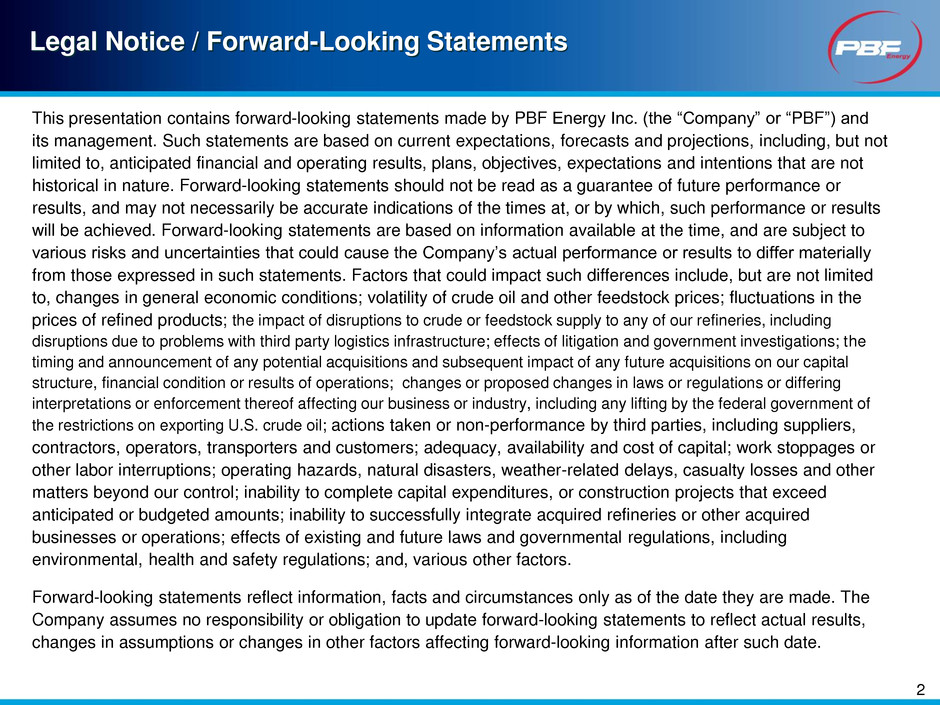
2 Legal Notice / Forward-Looking Statements This presentation contains forward-looking statements made by PBF Energy Inc. (the “Company” or “PBF”) and its management. Such statements are based on current expectations, forecasts and projections, including, but not limited to, anticipated financial and operating results, plans, objectives, expectations and intentions that are not historical in nature. Forward-looking statements should not be read as a guarantee of future performance or results, and may not necessarily be accurate indications of the times at, or by which, such performance or results will be achieved. Forward-looking statements are based on information available at the time, and are subject to various risks and uncertainties that could cause the Company’s actual performance or results to differ materially from those expressed in such statements. Factors that could impact such differences include, but are not limited to, changes in general economic conditions; volatility of crude oil and other feedstock prices; fluctuations in the prices of refined products; the impact of disruptions to crude or feedstock supply to any of our refineries, including disruptions due to problems with third party logistics infrastructure; effects of litigation and government investigations; the timing and announcement of any potential acquisitions and subsequent impact of any future acquisitions on our capital structure, financial condition or results of operations; changes or proposed changes in laws or regulations or differing interpretations or enforcement thereof affecting our business or industry, including any lifting by the federal government of the restrictions on exporting U.S. crude oil; actions taken or non-performance by third parties, including suppliers, contractors, operators, transporters and customers; adequacy, availability and cost of capital; work stoppages or other labor interruptions; operating hazards, natural disasters, weather-related delays, casualty losses and other matters beyond our control; inability to complete capital expenditures, or construction projects that exceed anticipated or budgeted amounts; inability to successfully integrate acquired refineries or other acquired businesses or operations; effects of existing and future laws and governmental regulations, including environmental, health and safety regulations; and, various other factors. Forward-looking statements reflect information, facts and circumstances only as of the date they are made. The Company assumes no responsibility or obligation to update forward-looking statements to reflect actual results, changes in assumptions or changes in other factors affecting forward-looking information after such date.
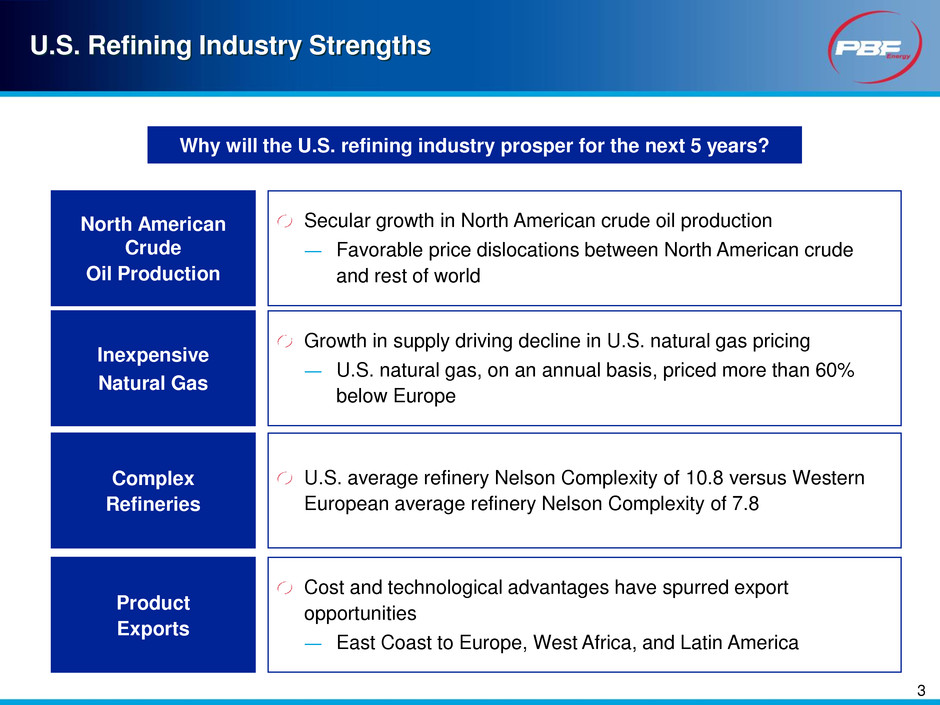
3 U.S. Refining Industry Strengths Inexpensive Natural Gas Growth in supply driving decline in U.S. natural gas pricing ― U.S. natural gas, on an annual basis, priced more than 60% below Europe North American Crude Oil Production Secular growth in North American crude oil production ― Favorable price dislocations between North American crude and rest of world Complex Refineries U.S. average refinery Nelson Complexity of 10.8 versus Western European average refinery Nelson Complexity of 7.8 Product Exports Cost and technological advantages have spurred export opportunities ― East Coast to Europe, West Africa, and Latin America Why will the U.S. refining industry prosper for the next 5 years?
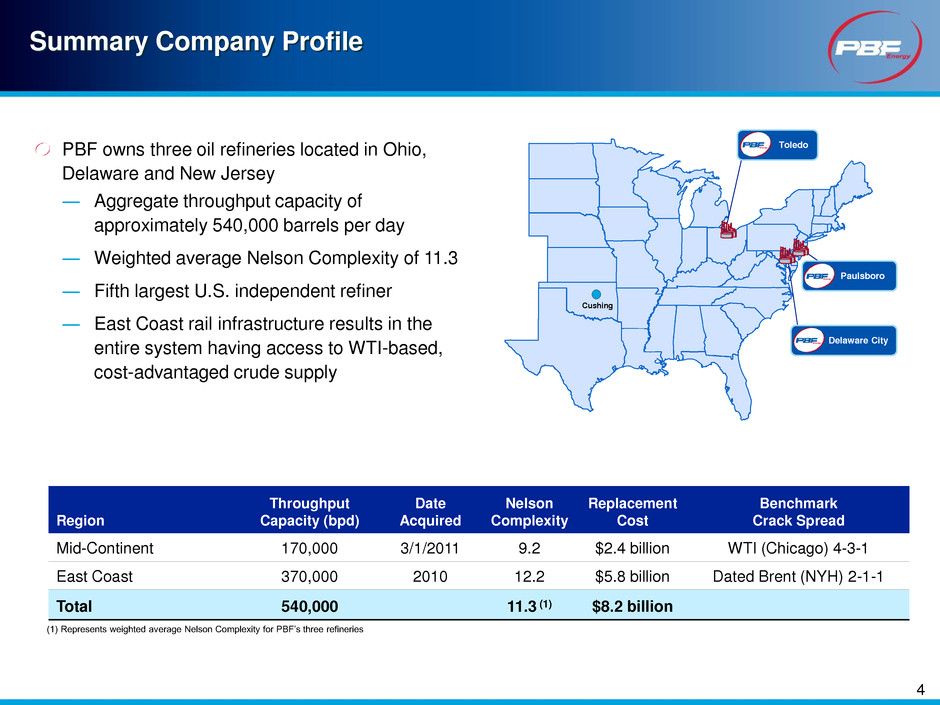
4 PBF owns three oil refineries located in Ohio, Delaware and New Jersey ― Aggregate throughput capacity of approximately 540,000 barrels per day ― Weighted average Nelson Complexity of 11.3 ― Fifth largest U.S. independent refiner ― East Coast rail infrastructure results in the entire system having access to WTI-based, cost-advantaged crude supply Summary Company Profile Cushing Toledo Paulsboro Delaware City Region Throughput Capacity (bpd) Date Acquired Nelson Complexity Replacement Cost Benchmark Crack Spread Mid-Continent 170,000 3/1/2011 9.2 $2.4 billion WTI (Chicago) 4-3-1 East Coast 370,000 2010 12.2 $5.8 billion Dated Brent (NYH) 2-1-1 Total 540,000 11.3 (1) $8.2 billion (1) Represents weighted average Nelson Complexity for PBF’s three refineries

5 Increasing East Coast access to currently cost-advantaged North American crude oil PBF’s onsite rail-infrastructure at Delaware City provides the opportunity to save approximately $3/bbl on delivered Bakken barrels versus using 3rd party facilities Approximate Delivery Capacity (Barrels per day) Today Year-end 2014 Light Crude Oil 105,000 130,000 Heavy Crude Oil 40,000 80,000 Total 145,000 210,000

6 Rail Operations Safety PBF will lead the way on rail safety New-style DOT-111A rail cars, also referred to as CPC-1232, ordered after October 1, 2011 are the most recent design and include thicker shells, half head shields, and protective coverings over the top fittings Effective April 1, 2014, all Bakken crude oil delivered to our Delaware City refinery will be transported in the new-style DOT-111A rail cars Effective June 30, 2014, 100% of the Canadian crude unloading activities at Delaware City will be from new-style DOT-111A rail cars PBF supports increased efforts by rail companies to enhance operating practices, increase rail inspection and maintenance activities to ensure the safe transport of Bakken crude oil
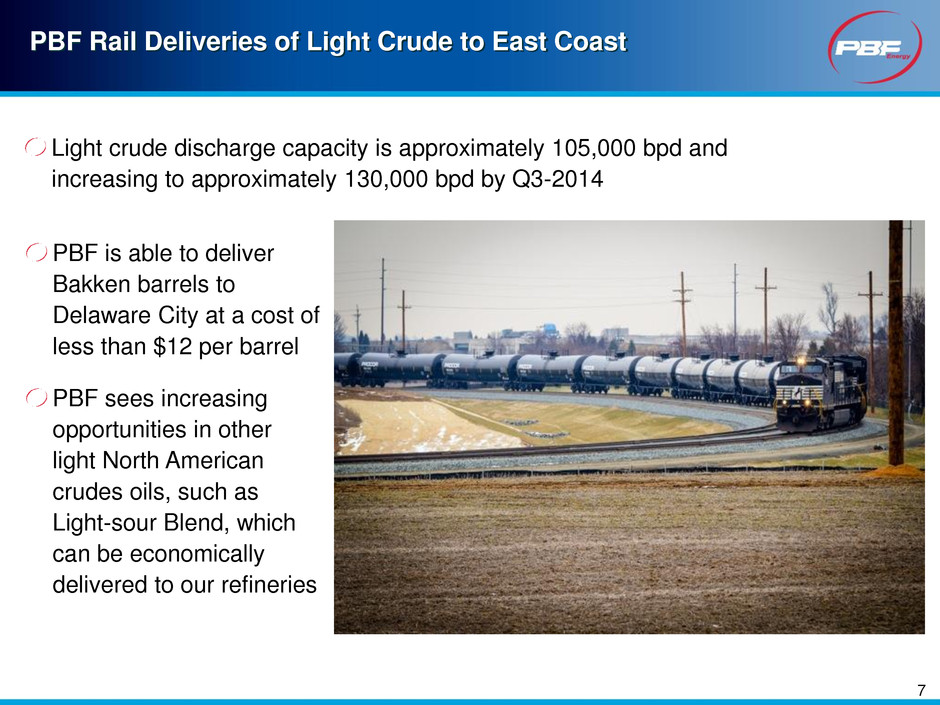
PBF Rail Deliveries of Light Crude to East Coast PBF is able to deliver Bakken barrels to Delaware City at a cost of less than $12 per barrel PBF sees increasing opportunities in other light North American crudes oils, such as Light-sour Blend, which can be economically delivered to our refineries 7 Light crude discharge capacity is approximately 105,000 bpd and increasing to approximately 130,000 bpd by Q3-2014
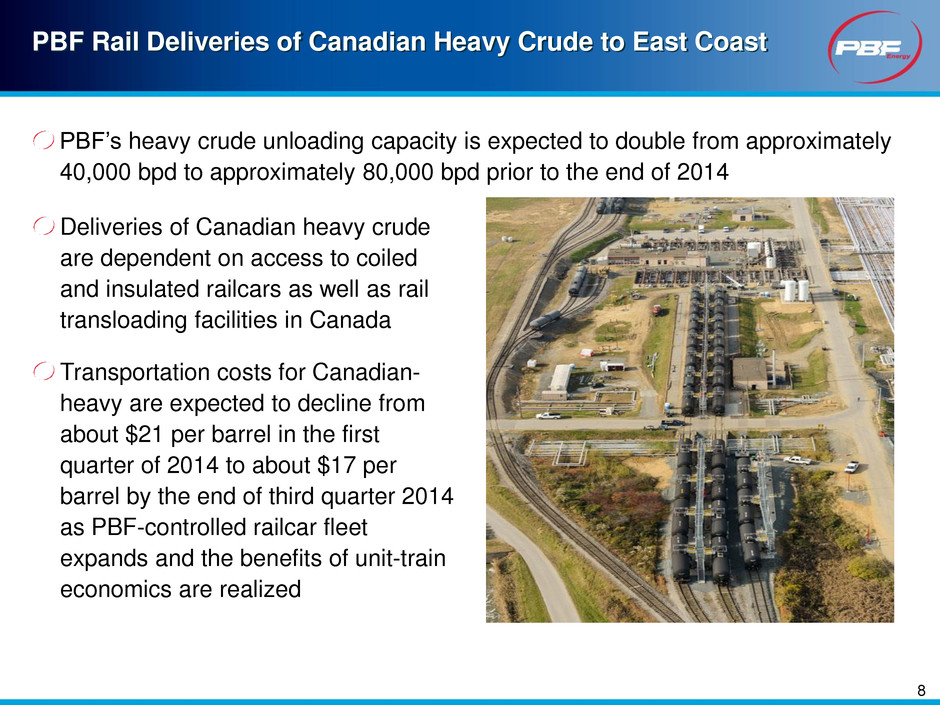
PBF Rail Deliveries of Canadian Heavy Crude to East Coast Deliveries of Canadian heavy crude are dependent on access to coiled and insulated railcars as well as rail transloading facilities in Canada Transportation costs for Canadian- heavy are expected to decline from about $21 per barrel in the first quarter of 2014 to about $17 per barrel by the end of third quarter 2014 as PBF-controlled railcar fleet expands and the benefits of unit-train economics are realized 8 PBF’s heavy crude unloading capacity is expected to double from approximately 40,000 bpd to approximately 80,000 bpd prior to the end of 2014

9 PBF’s Crude-by-Rail Program Planned Leased or Owned Railcars Note: Schedule is subject to change based on current company plans and on current third party railcar manufacturer delivery schedules Longer-term focus on logistics ― Rail services agreements with Norfolk Southern, BNSF, Savage ― Supply agreement with Continental Resources for Bakken PBF has shifted 1,000 Coiled and Insulated cars to new-style DOT-111A General Purpose cars in order to assure that only new cars are used for Bakken deliveries to Delaware City The total fleet number remains the same 1,818 1,945 2,024 2,317 2,700 3,300 3,600 3,600 1,286 1,300 1,399 1,700 1,867 2,150 2,300 2,300 - 1,000 2,000 3,000 4,000 5,000 6,000 1Q14 2Q14 3Q14 4Q14 1Q15 2Q15 3Q15 4Q15 Coiled & Insulated General Purpose
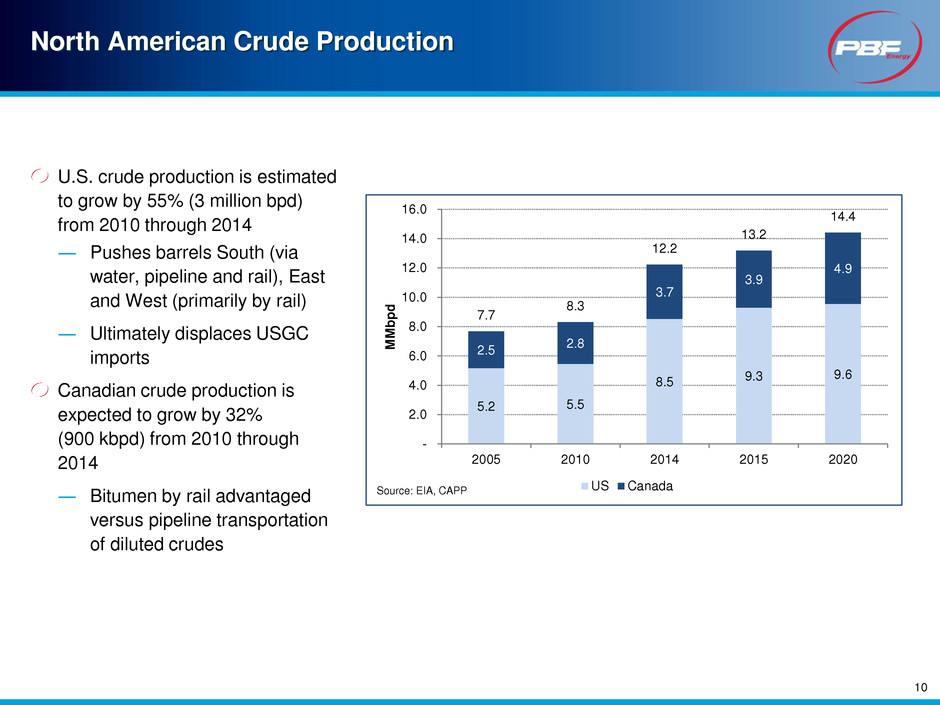
North American Crude Production U.S. crude production is estimated to grow by 55% (3 million bpd) from 2010 through 2014 ― Pushes barrels South (via water, pipeline and rail), East and West (primarily by rail) ― Ultimately displaces USGC imports Canadian crude production is expected to grow by 32% (900 kbpd) from 2010 through 2014 ― Bitumen by rail advantaged versus pipeline transportation of diluted crudes 10 5.2 5.5 8.5 9.3 9.6 2.5 2.8 3.7 3.9 4.9 7.7 8.3 12.2 13.2 14.4 - 2.0 4.0 6.0 8.0 10.0 12.0 14.0 16.0 2005 2010 2014 2015 2020 M M b p d US CanadaSource: EIA, CAPP
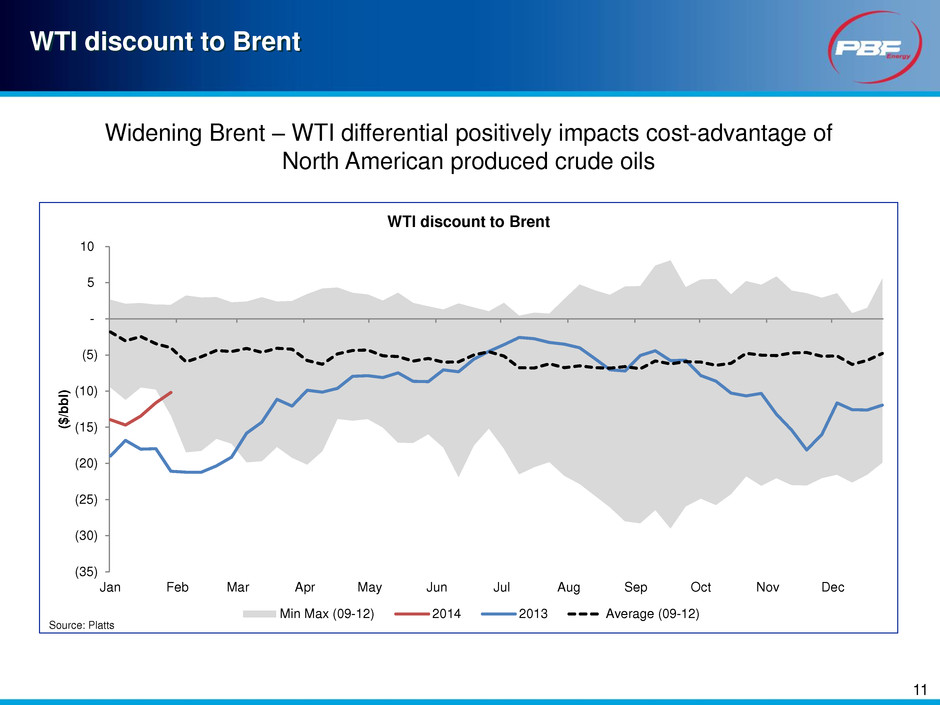
11 WTI discount to Brent Widening Brent – WTI differential positively impacts cost-advantage of North American produced crude oils (35) (30) (25) (20) (15) (10) (5) - 5 10 Jan Feb Mar Apr May Jun Jul Aug Sep Oct Nov Dec ($/b b l) WTI discount to Brent Min Max (09-12) 2014 2013 Average (09-12) Source: Platts
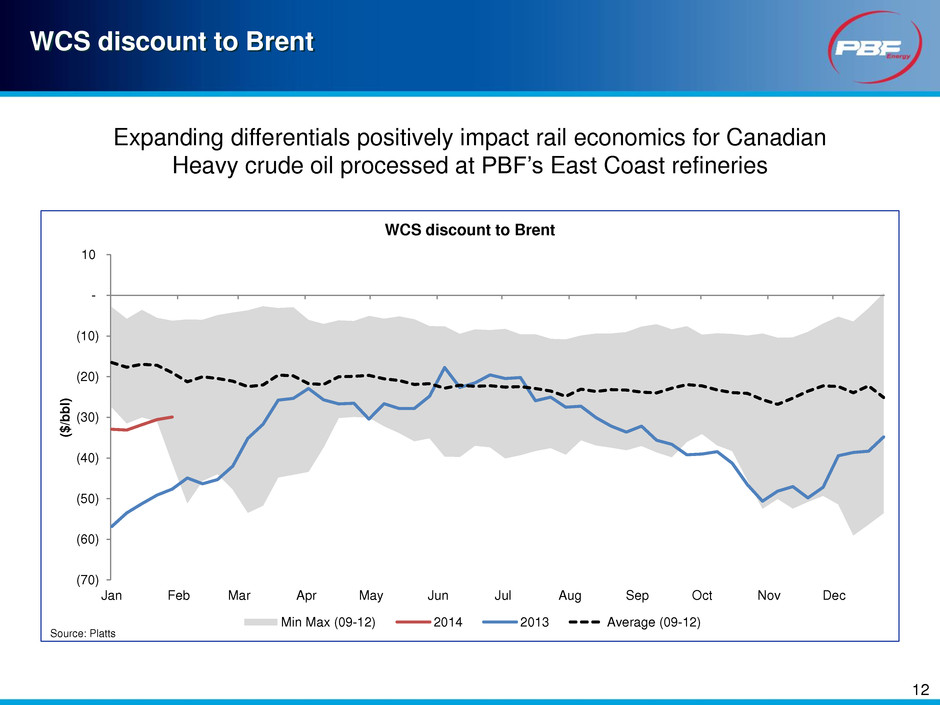
12 WCS discount to Brent Expanding differentials positively impact rail economics for Canadian Heavy crude oil processed at PBF’s East Coast refineries (70) (60) (50) (40) (30) (20) (10) - 10 Jan Feb Mar Apr May Jun Jul Aug Sep Oct Nov Dec ($/b b l) WCS discount to Brent Min Max (09-12) 2014 2013 Average (09-12) Source: Platts
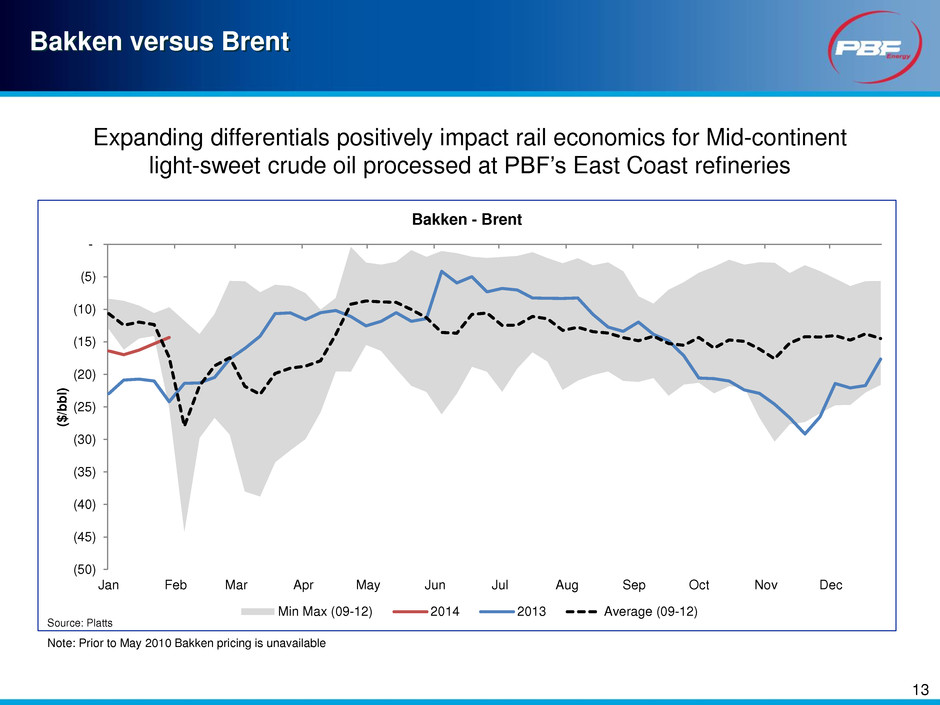
Bakken versus Brent 13 Note: Prior to May 2010 Bakken pricing is unavailable Expanding differentials positively impact rail economics for Mid-continent light-sweet crude oil processed at PBF’s East Coast refineries (50) (45) (40) (35) (30) (25) (20) (15) (10) (5) - Jan Feb Mar Apr May Jun Jul Aug Sep Oct Nov Dec ($/b b l) Bakken - Brent Min Max (09-12) 2014 2013 Average (09-12) Source: Platts
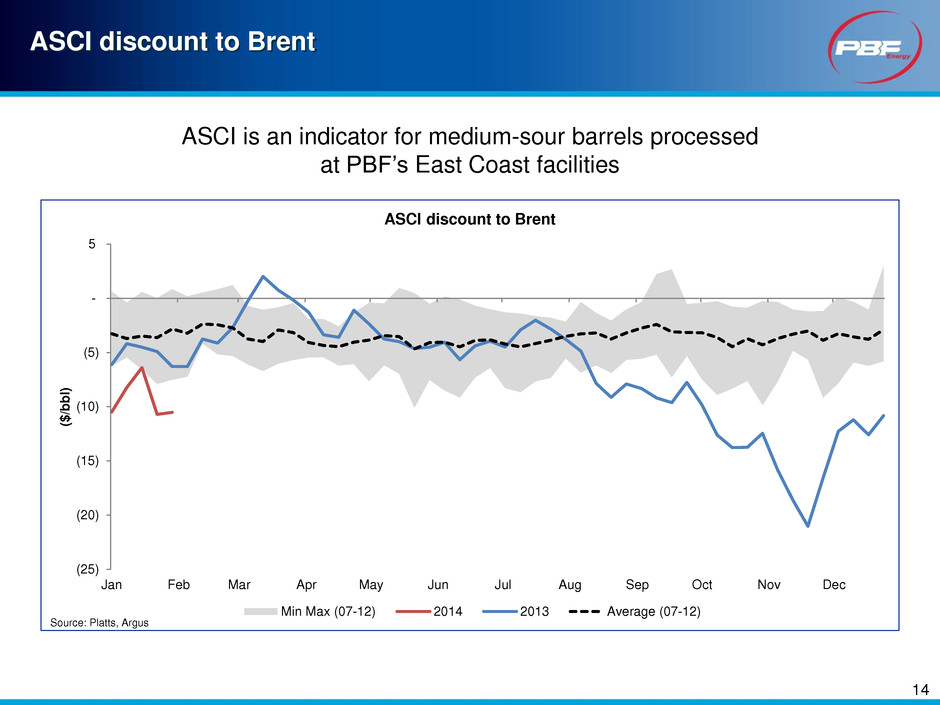
14 ASCI discount to Brent ASCI is an indicator for medium-sour barrels processed at PBF’s East Coast facilities (25) (20) (15) (10) (5) - 5 Jan Feb Mar Apr May Jun Jul Aug Sep Oct Nov Dec ($/b b l) ASCI discount to Brent Min Max (07-12) 2014 2013 Average (07-12) Source: Platts, Argus
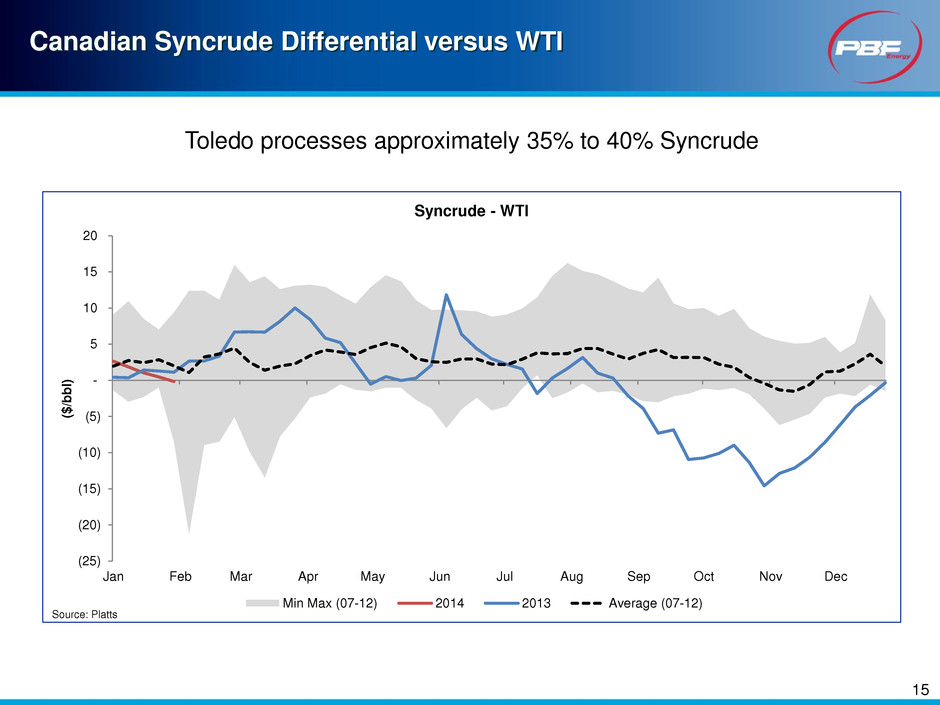
15 Canadian Syncrude Differential versus WTI Toledo processes approximately 35% to 40% Syncrude (25) (20) (15) (10) (5) - 5 10 15 20 Jan Feb Mar Apr May Jun Jul Aug Sep Oct Nov Dec ($/b b l) Syncrude - WTI Min Max (07-12) 2014 2013 Average (07-12) Source: Platts
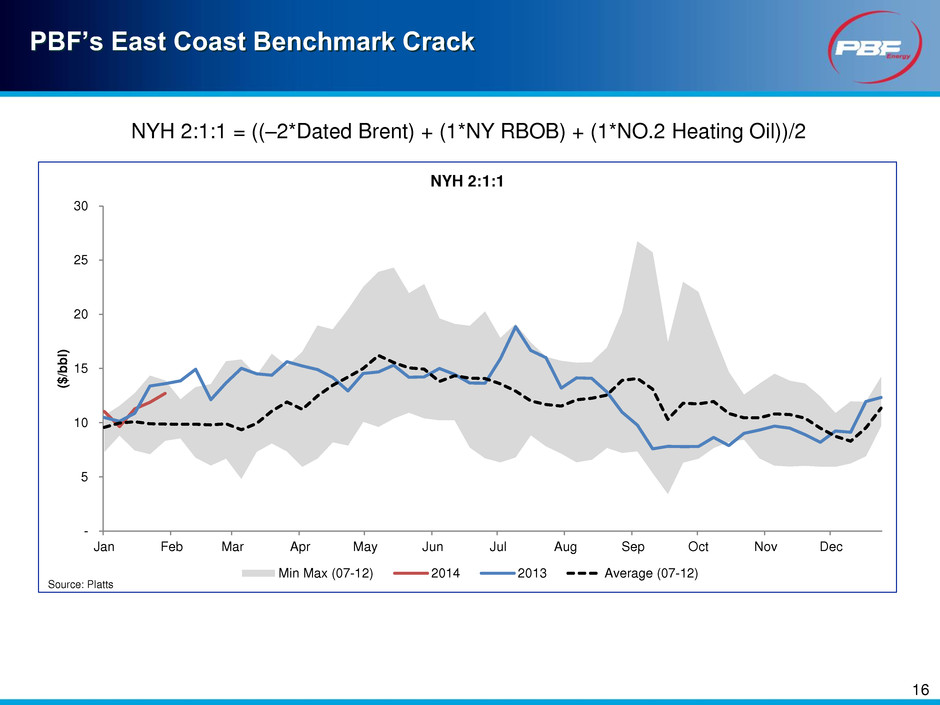
PBF’s East Coast Benchmark Crack 16 NYH 2:1:1 = ((–2*Dated Brent) + (1*NY RBOB) + (1*NO.2 Heating Oil))/2 - 5 10 15 20 25 30 Jan Feb Mar Apr May Jun Jul Aug Sep Oct Nov Dec ($/b b l) NYH 2:1:1 Min Max (07-12) 2014 2013 Average (07-12) Source: Platts
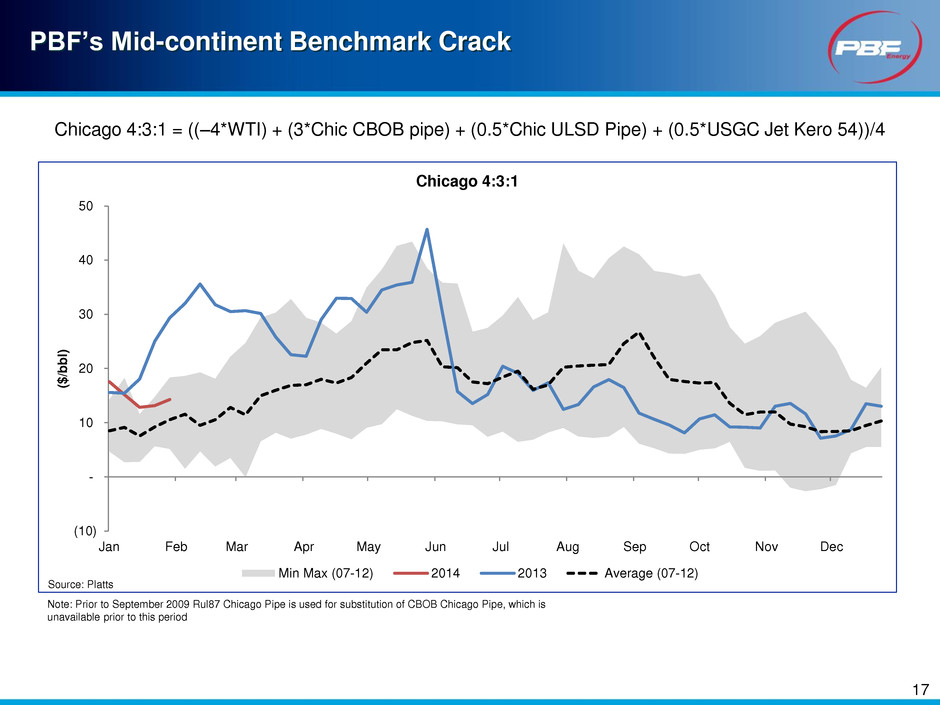
(10) - 10 20 30 40 50 Jan Feb Mar Apr May Jun Jul Aug Sep Oct Nov Dec ($/b b l) Chicago 4:3:1 Min Max (07-12) 2014 2013 Average (07-12) Source: Platts PBF’s Mid-continent Benchmark Crack Chicago 4:3:1 = ((–4*WTI) + (3*Chic CBOB pipe) + (0.5*Chic ULSD Pipe) + (0.5*USGC Jet Kero 54))/4 17 Note: Prior to September 2009 Rul87 Chicago Pipe is used for substitution of CBOB Chicago Pipe, which is unavailable prior to this period
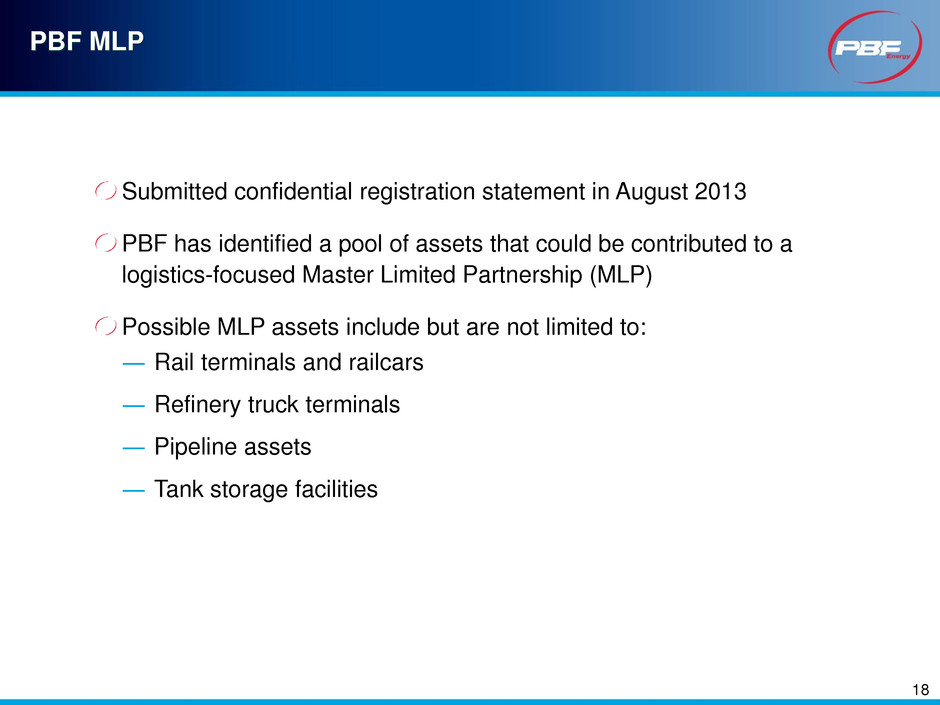
18 PBF MLP Submitted confidential registration statement in August 2013 PBF has identified a pool of assets that could be contributed to a logistics-focused Master Limited Partnership (MLP) Possible MLP assets include but are not limited to: ― Rail terminals and railcars ― Refinery truck terminals ― Pipeline assets ― Tank storage facilities


















